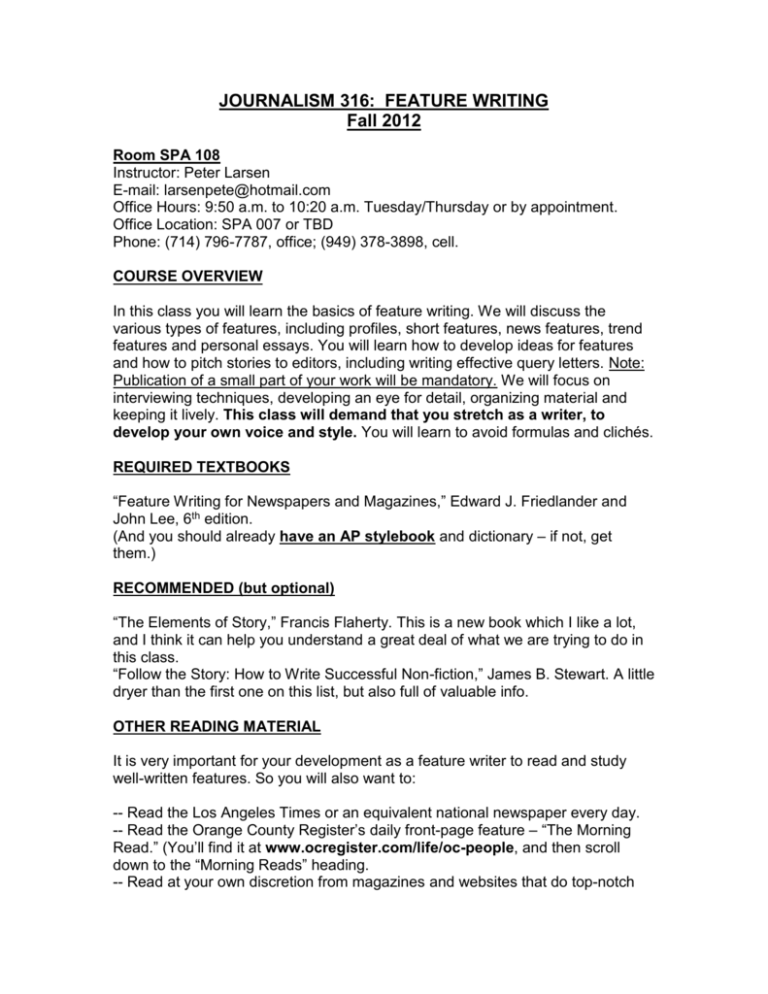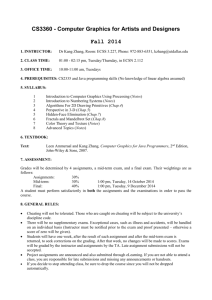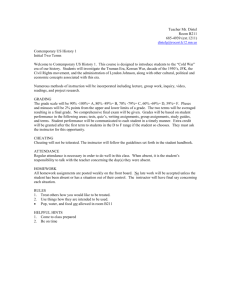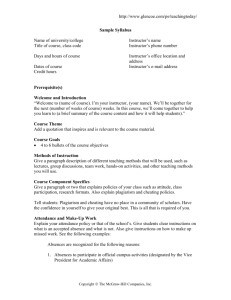JOURNALISM 316: FEATURE WRITING
advertisement

JOURNALISM 316: FEATURE WRITING Fall 2012 Room SPA 108 Instructor: Peter Larsen E-mail: larsenpete@hotmail.com Office Hours: 9:50 a.m. to 10:20 a.m. Tuesday/Thursday or by appointment. Office Location: SPA 007 or TBD Phone: (714) 796-7787, office; (949) 378-3898, cell. COURSE OVERVIEW In this class you will learn the basics of feature writing. We will discuss the various types of features, including profiles, short features, news features, trend features and personal essays. You will learn how to develop ideas for features and how to pitch stories to editors, including writing effective query letters. Note: Publication of a small part of your work will be mandatory. We will focus on interviewing techniques, developing an eye for detail, organizing material and keeping it lively. This class will demand that you stretch as a writer, to develop your own voice and style. You will learn to avoid formulas and clichés. REQUIRED TEXTBOOKS “Feature Writing for Newspapers and Magazines,” Edward J. Friedlander and John Lee, 6th edition. (And you should already have an AP stylebook and dictionary – if not, get them.) RECOMMENDED (but optional) “The Elements of Story,” Francis Flaherty. This is a new book which I like a lot, and I think it can help you understand a great deal of what we are trying to do in this class. “Follow the Story: How to Write Successful Non-fiction,” James B. Stewart. A little dryer than the first one on this list, but also full of valuable info. OTHER READING MATERIAL It is very important for your development as a feature writer to read and study well-written features. So you will also want to: -- Read the Los Angeles Times or an equivalent national newspaper every day. -- Read the Orange County Register’s daily front-page feature – “The Morning Read.” (You’ll find it at www.ocregister.com/life/oc-people, and then scroll down to the “Morning Reads” heading. -- Read at your own discretion from magazines and websites that do top-notch feature writing – such as “The New Yorker,” “Esquire,” “Vanity Fair,” “National Geographic,” “Rolling Stone,” “Sports Illustrated,” Salon.com, Slate.com, and so forth. CLASS PARTICIPATION Class participation is crucial, not only to your grade, but to your success as a reporter and writer. The more lively the in-class discussion, the more interesting the class will be and the more you will get out of it. Students who take the initiative will thrive here. Ask questions if something doesn’t make sense – there are no stupid questions. This is not a class in which sitting silently and taking notes will work all that well. It’s not primarily a lecture-style class. Discussion is key – so speak up! I can’t emphasize enough how much I want to hear you talk! ATTENDANCE and CLASS ETIQUETTE Attendance is also crucial. If you miss class, you are responsible for getting class notes and assignments from someone else in the class. A student with three unexcused absences may get an F in the class. To have an excused absence you must either talk to me before you plan to miss class, or talk to me ASAP after missing class and have an excuse along the lines of death in the family, serious illness, etc. Chronic tardiness will also hurt your grade, both in terms of your class participation points and by missing occasional quizzes to be given during the first 15 minutes of some classes. As for etiquette: Cell phones off and, please, don’t waste your time and mine by messing around on MySpace, Facebook, shopping, e-mail, etc. ASSIGNMENTS Stories for this class must be clear and readable with careful attention paid to grammar and AP style. Stories above all should be interesting. By making it into this class I’ll assume you already own an AP stylebook and a good dictionary. Stories are due in class when they are assigned and deadlines must be met. Late copy will only be accepted in rare circumstances, at my discretion. Assignments must be DOUBLE SPACED with headings in the upper left corner as in this example: James Osterberg J316 Larsen Sept. 15, 2011 (SLUG HERE IN CAPS) Word count: 900 LATE ASSIGNMENTS AND REWRITES No late assignments will be accepted without prior approval from me, and again, the threshold is high – death, serious illness, etc. Assignments are due during the first 15 minutes of class on the day they are assigned. Rewrites will be strongly encouraged. Rewrites will be accepted on stories written in the first two months of class/up to the midterm, and the rewrite grade will be your final grade. In other words, if your initial grade is a C but you rewrite it and improve it to an A, the A will be your grade on that assignment. However, that would require substantial reworking of your story – simply making the fixes I note in your original copy won’t do much to improve you grade. Rewrites must be done within two weeks of the date the original assignment was due. You need to turn in the original story with the rewrite. I firmly believe that by rewriting our stories we make them better, and have always been willing to let people take a second crack at a story in order to improve both story and grade. Grading will be tough in the first half of the semester partly to encourage you to rework stories that may get grades of C-F into second drafts worthy of As and Bs. GETTING PUBLISHED – AND EXTRA CREDIT It is a class requirement to get some of your work published. Some of you will have some experience getting published. A few of you might think it sounds daunting to do so, but I think you’ll see that it’s not that hard. Failing to do this may knock down your final class grade. Here are the details of what is required – you have options! The One-Story Option: If you get published by an off-campus publication for which you don’t already work and so have to pitch a story to an editor you don’t know, one story satisfies your requirement. The Two-Story Option: If you get published by an on-campus publication (Daily 49er, Dig) two stories satisfy this requirement. (If you work or intern at an offcampus publication, talk to me about how we’ll handle this. You’ll need to do something beyond the work assigned to you.) These stories can be ones you are writing for a class assignment, or they can be extra stories (not a class assignment). Other published stories beyond the one or two that are mandatory may qualify for extra credit. Please attempt this -- the practical experience you will gain is invaluable. CRITICISM A critical skill for any good journalist is the ability to take constructive criticism and apply it to your stories. It’s not always easy, but the best writers embrace feedback to improve their work. Here you will learn how to take AND GIVE constructive criticism, and use it to improve your craft. COURSE GRADES: Attendance, in-class writing exercises and quizzes: 20 percent Feature writing assignments -- graded: 20 percent Midterm: a 1,000- to 1,500-word piece: 30 percent Final: a 1,500- to 2,000-word piece: 30 percent GRADING CRITERIA Stories will be graded on how successfully you have researched, reported and written your feature concept. As with any journalism, you’ll also be graded on accuracy, clarity, organization, AP style, fairness/balance, completeness/omissions, grammar, punctuation, spelling and the ability to meet deadlines. Don’t be discouraged if your first few stories aren’t highly graded. This class is about learning to be a writer, and stretching to reach that goal. Each story will have a letter grade -- improvement will earn higher grades. (See “Rewrite” section above.) Stories will be graded as follows: 1) An “A” story is exceptional. It is well written and requires only minor editing. In other words, it’s publishable. 2) A “B” story needs more than minor editing and may have spelling or style errors. Writing is poorly organized or it may need more details and reporting to be compelling. 3) A “C” story needs considerable editing and may have other writing or style problems. 4) A “D” story is substandard and an “F” story has even more problems. For instance, make major factual errors and you’re likely looking at an “F” story. A word on writing your stories: Your writing can improve with each draft -- expect to write more than one. Read the story aloud, to yourself or someone else, to see if it makes sense to the ear. Print it out and review it with a pen or pencil in hand to catch typos and/or make changes. Do not put your trust in Microsoft Word spelling and grammar checks -- many errors will be missed! A word on deadlines: they matter in journalism and this class. An assignment turned in the day after it is due will be marked down one letter grade; on the second day it will be marked down two letter grades. Any assignment that is more than two days late merits an F. (However, an F is much better than not turning in an assignment at all, in that I may, at my discretion, let you rewrite or improve the story to improve the grade.) And remember: grades are not an end in and of themselves. They are the best means instructors can come up with to help you learn. Comments from me and comments from your classmates are a reflection of your work, not you. As noted above, successful writers learn to embrace constructive criticism. Finally: If you are struggling, ask me for help. That’s why I am here! Note: Discussions of grades during the semester should not be construed as promises or predictions ACCURACY, INTEGRITY AND FAIRNESS As in any journalism course or real-world story assignment, you are expected to demonstrate the highest standards of accuracy, integrity and fairness in your work. Sources are to be attributed with first and last names. Any student found guilty of plagiarism, fabrication, cheating on examinations, or other assignments will immediately receive a failing grade in the course. There are no exceptions to this policy. (The final pages of this syllabus spell out policies on grading, conduct of classes, drops, and cheating.) INSTRUCTOR BIO Peter Larsen has been a journalist for more than 25 years. At the Orange County Register, he currently covers pop culture such as TV, music, movies and books. He also writes a pop culture blog at www.ocregister.com/pedrowatcher. In 15 years total at the Register, he’s also covered government, politics, and generalassignment stories. Earlier in his career he spent seven years at the Los Angeles Daily News, covering Los Angeles City Hall and general assignment news, and the Belleville News-Democrat in Illinois, covering pretty much everything. He graduated from Lewis and Clark College in Portland, Ore. with degrees in English and Communications, and later earned a Masters at the Medill School of Journalism at Northwestern University. CLASS SCHEDULE Note: This syllabus and assignments will almost certainly change over the semester, adjusting to meet the needs and interests of the class. I will tell you when this happens, but then it’s up to you to keep tabs on the current expectations. Week 1: Aug. 28: WHAT IS A FEATURE STORY? How is it different than a news story? It’s certainly not easier to report and write than a news story. We’ll look at the deadline news feature, the profile, the BLT (bright, light and tight), the explanatory feature and others. For Tuesday, introductions, course overview, review of syllabus and assignments. In-class writing assignment. For Thursday, read Chapter 1 of Friedlander book, paying special attention to the 15 types of feature stories. Also come to class with a feature story you found and liked in the newspaper, magazine, etc. We’ll discuss those and also Chapter 1/Friedlander. Week 2: Sept. 4: Tuesday: CURIOSITY. Where do feature story ideas come from? Read Chapter 2/Friedlander and handout I’ll e-mail you or post online. We’ll discuss both. This week we’ll also begin a graded student profile assignment. Week 3: Sept. 11: INTERVIEWING. Techniques for the feature story. Read Chapter 5/Friedlander. Pay careful attention to the types of questions. Read James B. Stewart’s chapter on “Gathering Information.” It is Chapter 4 in “Following the Story,” an optional book for this class, but if you have not purchased it will be available as a handout. QUERY LETTERS. How to write them, how to get published as a freelancer. A look at current trends in query letters. Read Chapter 8/Friedlander, paying careful attention to the section on these letters. Write a query letter for your student profile, with attention given not just to the contents of the letter, but to the publication at which you are pitching it. Then pitch the final feature to the class in small groups. Note: We will likely incorporate query letter-writing into future story assignments, too, which will help you as you look for ways to fulfill the story publication requirement of the class. Week 4: Sept. 18: FOCUSING. How to focus and narrow your feature story idea into a piece that makes sense and is compelling. Read Chapter 3/Friedlander and handouts. (“The Struggles of Otter 76,” possibly.) For Tuesday, bring in three feature ideas for your midterm. For Thursday, Sept. 20 your student profiles are due. Week 5: Sept. 25: THE SHORT PROFILE. We will have a guest visit the class, and you will practice your interview techniques on our guest. Then you’ll write a 500-800 word profile of him or her. The profile will be due Thursday or following Tuesday. Week 6: Oct. 2: LEADS. Feature leads and the many ways they can be crafted. A look at descriptive leads, direct leads, freak leads, anecdotal leads, etc. Read Chapter 6/Friedlander, the section titled “Writing the Lead,” pages 178-194. Week 7: Oct. 9: DETAIL. Developing your eye for detail. How to get the stuff that makes your writing sing. How to know what to keep and what to cut in a story. Read Chapter 8/Stewart on “Description” if you have it, handout available if you don’t. Other handouts, possibly from “The Elements of Story, too. MIDTERMS probably DUE THIS WEEK. Week 8: Oct. 16: STRUCTURE. How to organize a feature story so that it holds together, makes sense and keeps a reader’s attention. Read the rest of Chapter 6/Friedlander (remember, you read the section on leads two weeks ago.) Week 9: Oct. 23: PULLING IT TOGETHER. We’ll do some reviewing this week of the semester so far. Focus on how to turn a critical eye on your work: as a writer, editor and reader. Read the 2006 Pulitzer Prize-winning feature from the Rocky Mountain News. Also: you will need to bring your Final ideas, three pitches for a feature of 1,500- to 2,000 words. Critique mid-terms. Week 10: Oct. 30: Tuesday: PROFILES. What makes a good profile? Read Chapter 7/Friedlander, “Writing the Specialized Feature.” Thursday: RESEARCHING THE FEATURE. Reporting for feature stories. The more you get, the better it is – even, paradoxically, if you throw half of it out! Read Chapter 4/Friedlander. Also: Thursday, possible/probably Halloween-themed story due. Week 11: Nov. 6: PERSONAL ESSAYS. What makes a good personal essay? Read handouts of some I think are great. Personal essay/review assignment, 600- to 800-word piece. Week 12: Nov. 13: Tuesday: NO CLASS, Tuesday classes are cancelled for Veterans Day holiday. Thursday: MAKING A GREAT ‘BLT.’ The bright, light and tight – usually just referred to as a ‘bright’ – is a short feature, often written on deadline, that’s a staple of every newsroom. Handouts of great examples will be provided. Week 13: Nov. 20: Tuesday: Locking in ideas for your finals, which you’ll recall will not be a test, but instead a 1,500-2,000 word story. Also possibly have a guest speaker this class. Thursday: THANKSGIVING holiday, no class! Week 14: Nov. 27: ETHICS. Brushing up on your legal and ethical considerations as a writer. Read Chapter 10/Friedlander and handouts. In-class writing assignments. Week 15: Dec. 4: Last week of classes: CATCH-UP WEEK. Here we’ll deal with any issues that need extra attention and things we might not have gotten to yet. But primarily this week should be a “Final help week” – in other words, your chance to meet and discuss your progress, problems and how to reach the finish line. Week 16: Dec. 11: FINALS DUE THIS WEEK: Our exam period is from 8 a.m. to 10 a.m. on Thurs. Dec. 13. Attachment No. 1 Addendum to Course Syllabus: Department of Journalism Policies on Grading, Conduct of Classes, Drops, Absences and Cheating Grading: The grading policies and practices in this class are explained elsewhere in the syllabus. It is the student’s responsibility to read them and to seek clarification if necessary. The student should be fully aware of what is required for success in the course, such as group participation, writing, speaking, completing assigned readings, etc. Seat in Class: An enrolled student may lose his/her seat in class if he/she misses the first class meeting without notifying the instructor. At the instructor’s discretion, a student who attends the first class but not subsequent classes may also be dropped from the course. Withdrawal from Class: Students may withdraw from a class from the third to the 12th week for “serious and compelling reasons.” Normally these are defined as anything of import that is beyond the control of the student. This includes, but is not necessarily limited to, death or serious illness in a student’s immediate family or a documented change in a student’s work schedule. Poor performance, tardiness and unexcused absences are not considered a serious or compelling reason beyond the student’s control for purposes of withdrawal. Absences from Class: Grades in a course may be adversely affected by absences, and students should seek clarification from the instructor regarding the course absence policy. Make-ups usually are granted in strict accordance with CSULB policy, which defines excused absences as (1) illness or injury to the student; (2) death, injury or serious illness of an immediate family member or the like; (3) religious reasons; (4) jury duty or government obligation; (5) CSULBsanctioned or approved activities [2002-03 Catalog, p. 75]. These and any other requests for an excused absence must be documented. CSULB Cheating/Plagiarism/Fabrication Policy: CSULB takes issues of academic dishonesty very seriously. If you use any deceptive or dishonest method to complete an assignment, take an exam, or gain credit in a course in any other way, or if you help someone else to do so, you are guilty of cheating. If you use someone else’s ideas or work and represent it as your own without giving credit to the source, you are guilty of plagiarism. This does not apply if the ideas are recognized as common knowledge, or if you can show that you honestly developed the ideas through your own work. Any instructor can show you the correct ways of citing your sources, and you should use quotation marks, footnotes or endnotes and bibliographic references to give credit to your sources according to the format recommended by your instructor. Responses, Penalties and Student Rights: Students should consult the appropriate sections of the Catalog for examples of cheating, fabrication and plagiarism, and instructor and/or CSULB response options in such circumstances. The Catalog also outlines student rights. Any instance of academic dishonesty may result in your immediate expulsion from the class with a grade of “F” and/or other sanctions, as the instructor deems appropriate. Attachment No. 2: Additional Student Learning Assessment The national accrediting agency for journalism education has established a requirement that all accredited journalism schools assess student mastery of 11 core values and competencies that any graduate of a journalism and mass communication program should possess. According to the Accrediting Council on Education in Journalism and Mass Communication, all graduates, irrespective of their particular specialization, should be able: 1) Understand and apply First Amendment principles and the law appropriate to professional practice. 2) Demonstrate an understanding of the history and role of professionals and institutions in shaping communications. 3) Demonstrate an understanding of the diversity of groups in a global society in relationship to communications. 4) Understand concepts and apply theories in the use and presentation of images and information. 5) Work ethically in pursuit of truth, accuracy, fairness and diversity. 6) Think critically, creatively and independently. 7) Conduct research and evaluate information by methods appropriate to the communications professionals in which they work. 8) Write correctly and clearly in forms and styles appropriate for the communications professions, audiences and purposes they serve. 9) Critically evaluate their own work and that of others for accuracy and fairness, clarity, appropriate style and grammatical correctness. 10) Apply basic numerical and statistical concepts. 11) Apply tools and technologies appropriate for the communications professions in which they work.





